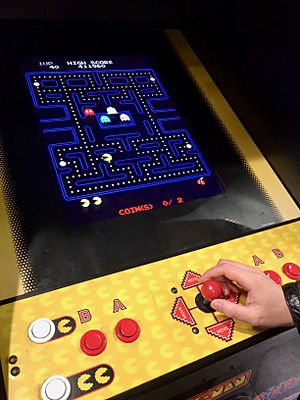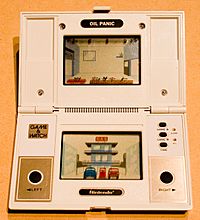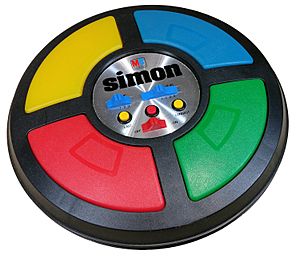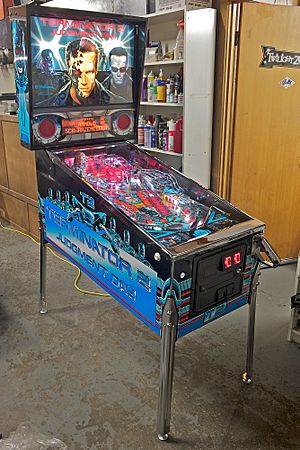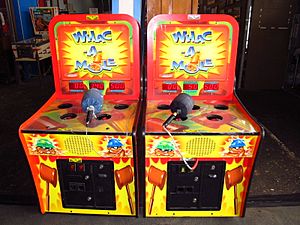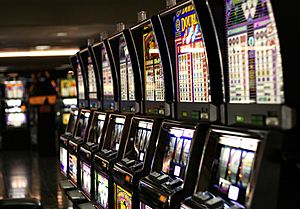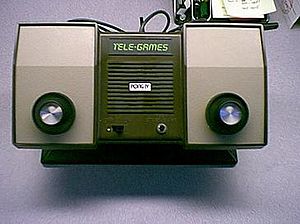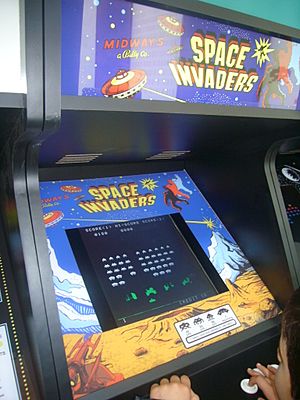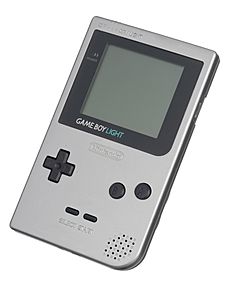Electronic game facts for kids
An electronic game is a fun activity you play using electronics. These games create an interactive system for you to enjoy. The most common type today is the video game. Because of this, people often use "electronic game" and "video game" to mean the same thing. But electronic games also include things like handheld electronic games, pinball machines, and even audio games that you play just by listening!
Contents
Handheld Electronic Games: Play Anywhere!
Handheld electronic games are small and easy to carry. They let you play interactive games wherever you go. Often, they are smaller versions of video games. All the controls, the screen, and the speakers are built into one device.
Unlike modern screens with lots of tiny pixels, these older handhelds usually had special displays. These displays were made just for one specific game. This simple design meant they could be very small, sometimes even built into a digital watch! Their screens could show simple lights, LEDs, or calculator-like numbers. Later, they used LCD and VFD screens with more detailed pictures and even color.
Handhelds were super popular from the late 1970s to the early 1990s. They were the first step towards today's handheld game consoles and were also a cheaper way to play games.
Here are some famous handheld electronic games:
- Mattel Auto Race (1976)
- Simon (1978)
- Merlin (1978)
- Game & Watch (1979)
- Bandai LCD Solarpower (1982)
- Entex Adventure Vision (1982)
- Lights Out (1995)
Pinball Machines: Flippers and Fun!
Pinball machines have used electromechanics since 1933. This means they use both electricity and moving parts. Electronics help keep score on the backglass (the upright part of the machine). They also power the bumpers and flippers on the playfield. These parts make the game exciting!
Unlike video games with screens, pinball still has a physical game area. You play by hitting a ball around a table under glass. Other games like pachinko also use more and more electronics today.
Some popular pinball games include:
- The Addams Family (1991)
- Indiana Jones: The Pinball Adventure (1993)
- Star Trek: The Next Generation (1993)
- You can find many more on the List of pinball machines.
Redemption and Merchandiser Games: Win Prizes!
Redemption games like Skee Ball have been around for a long time. They were popular at carnivals even before electronic games existed. Now, many of these games use electronics for scoring and other parts of the game. This makes it easier for arcade workers. They just give out prizes for the tickets you win.
Merchandiser games, like the Claw Crane, are also electronic. In these games, you try to do a simple task, like moving a mechanical arm. If you do it well enough, you win a prize!
Examples of redemption games:
- Whac-A-Mole (1971)
- Skee Ball (modern electronic versions)
An example of a merchandiser game:
- Claw crane (1980)
Slot Machines: Spinning Reels
A slot machine is a type of electronic game often found in casinos. It has three or more spinning reels. You push a button to make them spin. Older machines had a side lever to pull, which is why they were sometimes called "one-armed bandits." Many modern machines still have a lever, even though you usually push a button.
Slot machines have a currency detector to check the money you put in. The machine pays out if certain symbols line up when the reels stop. Modern computer technology has led to many different kinds of slot machines.
Arcade Games: Classic Fun!
Electronic video arcade games use lots of electronics and integrated circuits. In the past, coin-operated arcade games often had special hardware just for that game. This included multiple CPUs and unique sound and graphics chips. Today, arcade games often use parts similar to those found in home video game consoles or powerful PCs.
Arcade games are known for their special controls and setups. This might include fully enclosed cabinets with force feedback controls, lightguns, or even controllers shaped like motorcycles or fishing rods! These unique accessories make arcade games feel very immersive and realistic.
Here are some famous arcade games:
- Galaxy Game (1971)
- Pong (1972)
- Space Invaders (1978)
- Galaxian (1979)
- Pac-Man (1980)
- Battlezone (1980)
- Donkey Kong (1981)
- Street Fighter II (1991)
- Mortal Kombat (1992)
- Fatal Fury (1992)
- King of Fighters (1994–2005)
- Time Crisis (1995)
- Dance Dance Revolution (1998)
- DrumMania (1999)
Computer Video Games: Play on Your PC
A personal computer video game (or PC game) is a video game you play on a personal computer. This is different from playing on a video game console or an arcade machine. Most computer games today are video games. Since the very beginning, screens like the cathode ray tube have been used to show game information.
Console Games: Home and Handheld Fun

A console game is an interactive game made for entertainment. The game creates images and sounds using a video game console. You see these on a television or similar screen. You usually control the game with a handheld device called a controller. This controller has buttons and directional controls, like analog joysticks, to help you interact with the game.
Sometimes, the screen, speakers, console, and controls are all in one small device. This is called a handheld game console.
Console games are often grouped by the type of console they play on:
- Traditional console (or "home console"): These are systems that use a TV screen for graphics.
- Handheld game console: These systems have their own screen and controls built into one portable device.
- Dedicated console: These systems usually play only one game. They can be "plug and play" or LCD games.
- Educational console: These consoles mainly support educational games. They are often made simpler for children to use.
Within these groups, consoles are also sorted by who made them and when they were released. Console games are also often grouped by their game genre.
Other Electronic Games
Electronics are used in many different types of games. Some board games, like Dark Tower, rely heavily on electronics. There are also unique electronic games like Rubik's Revolution. Even electronic toys that are a mix between games and toys, like the Electronic Magic 8 Ball Date Ball or the Electronic Ouija Board, are often seen as electronic games.
Electro-mechanical Games: Old School Arcade
These were types of arcade games that came before modern video games. They used electro-mechanical parts to make sounds or images instead of a screen. They were popular in the 1960s and 1970s. But then, video games became much more popular starting around 1978.
An early example was Sega's Periscope in 1966. It was a submarine simulator and light gun shooter. It used lights and plastic waves to show ships sinking from a submarine. Sega also made gun games that looked a bit like first-person shooter video games. But they were electro-mechanical games that used rear image projection to show moving animations on a screen. One example was the light gun game Duck Hunt from 1969. It had moving targets, printed your score on a ticket, and had sound effects you could control.
See also
 In Spanish: Juego electrónico para niños
In Spanish: Juego electrónico para niños


